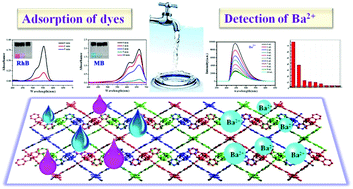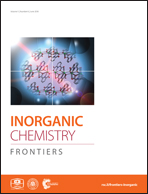A 2D porous pentiptycene-based MOF for efficient detection of Ba2+ and selective adsorption of dyes from water†
Abstract
Cleaning wastewater has become increasingly important with the rapidly increasing population and urbanization throughout the world. In particular, the removal of inorganic and/or organic toxicants from wastewater plays a significant role in water pollution treatment technology as more and more areas face water stress issues. Till now, several water treatment options have been taken up to achieve the purity requirement for multipurpose usages. Here, we describe an excellent water-stable porous metal–organic framework, named UPC-28, based on a pentiptycene ligand to purify water. UPC-28 exhibits efficient detection of Ba2+ with the calculated quenching constant, Ksv, being 8.97 × 105, indicating that UPC-28 can serve as a promising Ba2+ luminescent probe. Furthermore, UPC-28 can rapidly and selectively adsorb the cationic dyes, rhodamine B (RhB) and methylene blue (MB), due to its anionic framework interacting strongly with cationic dyes.



 Please wait while we load your content...
Please wait while we load your content...